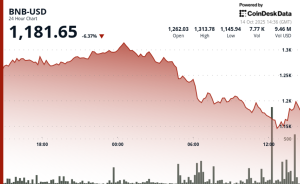Key Insights
- Hedera ended Q4 with an all-time high in TVL. The increase was driven by the sustained success of SaucerSwap and the launches of HeliSwap and Bubbleswap.
- Multiple Hedera Network Services set all-time highs. The Consensus Service, Crypto Service, and Smart Contract Service experienced significant growth, while the Token Service showed less progress.
- The Hedera Governing Council added its 27th member. The Council also announced the appointments of two C-suite executives.
- The Hedera Treasury had no exposure to FTX or Genesis. Approximately 51% of the total supply (25.3 billion HBAR) is in circulation.
Primer on Hedera
Hedera is a public-permissioned Proof-of-Stake (PoS) blockchain network. It is governed by 27 global enterprises, known as the Hedera Governing Council, with input from the community via Hedera Improvement Proposals (HIPs). Members of the Governing Council operate Hedera’s validator nodes while the network transitions to permissionless node hosting. Although Hedera’s network operation is currently permissioned in nature, the division of responsibility across each of the 27 geographically and industry diversified (collusion-proof) council members is unique among public DLTs. This governance structure physically prevents aggregation of hash rate or stake to the same point that is threatening the security of other public ledgers.
Hedera offers developers core services, known as the Hedera Network Services, to build decentralized applications. The network is powered by the Hashgraph Consensus Algorithm, which offers high throughput, fair ordering, and low-latency consensus.
Key Metrics
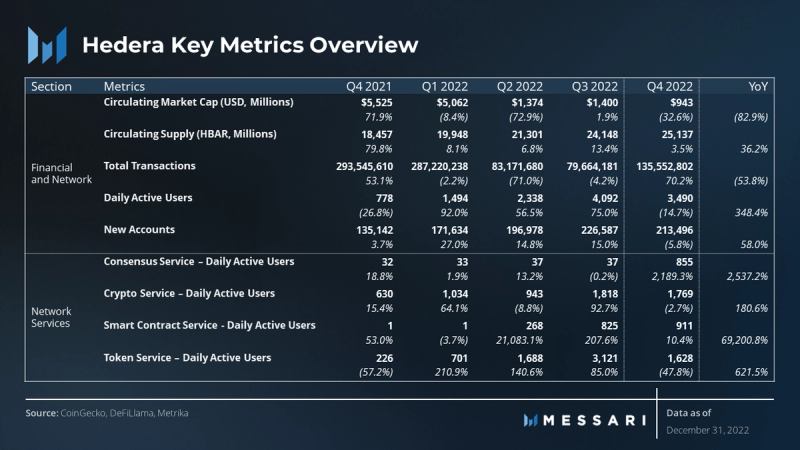
Performance Analysis
Financial and Network Overview
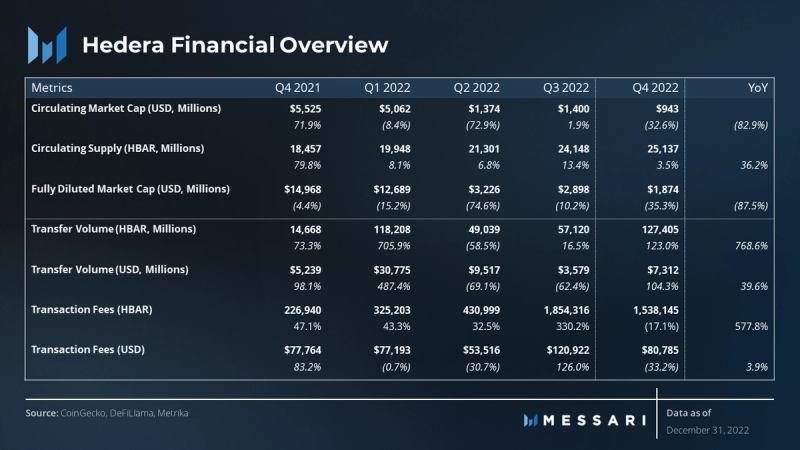
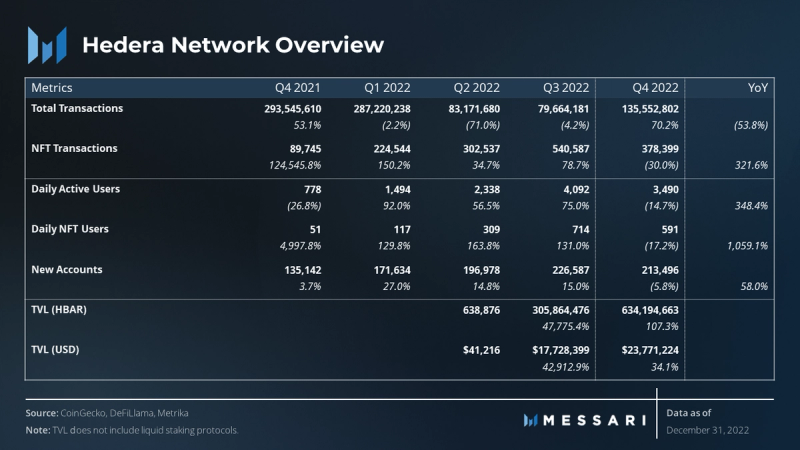
The crypto industry was shaken by the collapse of FTX in November, adding to an already historically difficult year for the sector. Hedera was affected by the market downturn, experiencing a 33% decline in market capitalization QoQ, falling from $1.4 billion to $943 million, and an 83% YoY drop.
Despite the negative price action, Hedera’s fundamentals maintained momentum after a strong Q3. During Q4, Hedera’s transfer volume and transactions were up 123% and 70%, respectively. Concurrently, both daily active users and new accounts dropped slightly after setting all-time highs in Q3, but remained well above prior quarters. The heightened activity paired with marginally reduced users suggests current users are highly active on the network.
DeFi
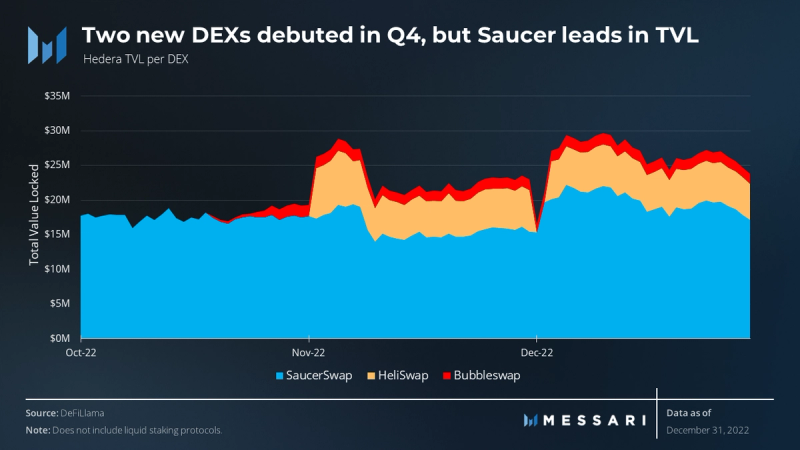
Hedera’s first decentralized exchange (DEX), SaucerSwap, launched in Q3 and was an instant hit, amassing over $10 million in total value locked (TVL) and boosting network services performance. In Q4, SaucerSwap further expanded, reaching an all-time high of $22 million in TVL.
In Q4, two new DEXs, HeliSwap and Bubbleswap, also launched. Together, these two DEXs accumulated nearly $10 million in TVL. At the end of Q4, Hedera had a TVL of $23 million. This growth in TVL is particularly noteworthy, as the Hedera DeFi ecosystem only recently launched in Q2 2022. Overall, expect the Hedera DeFi ecosystem to continue expanding as the DeFi-focused fund starts to show results.
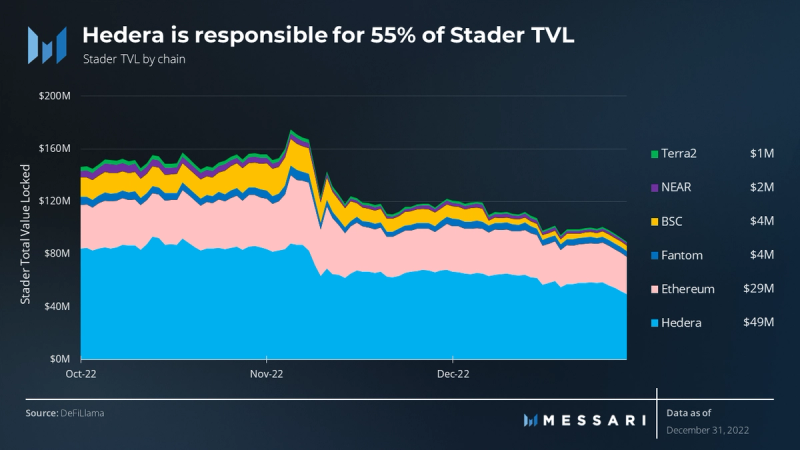
Stader, another DeFi protocol in the Hedera ecosystem, is a multichain liquid staking platform. At the end of Q4, Stader had $90 million in TVL, of which $49 million (55%) came from Hedera. When combining the TVL of the liquid staking protocol Stader with the DEXs, Hedera had a total of approximately $75 million in TVL.
NFTs and Gaming

After reaching all-time highs in daily active users and transactions in Q3, and being utilized by Hedera Governance Council member LG, the Hedera NFT sector experienced a slight decline in Q4. Despite this, the sector continued to progress with the launch of several new projects and announcements:
- Zoop – a digital celebrities trading card platform, announced new funding and two key partnerships in advance of its highly anticipated launch.
- Clout.art – a platform allowing users to connect their instagram accounts and mint their posts, migrated from Polygon to Hedera.
- Numbers – which makes digital media traceable and verifiable through a novel process, launched on Hedera mainnet.
- RoadCode – cycling’s first fan universe providing behind the scenes access, special information, and games to fans, announced it will be launching on Hedera.
- Mintbar – an open sourced NFT minter designed to accelerate the adoption of the Hedera NFT ecosystem, was announced.
- enoughteaFoundation – facilitated an NFT auction to raise humanitarian funds for Ukraine.
The Hedera gaming sector, while not as advanced as the NFT sector, remains a promising area to watch. In Q3, Liithos, a new AAA gaming and entertainment studio led by former PlayStation executives, announced plans for their first game, Ashfall. Additionally, the HBAR foundation announced funding for multiple games including Meta Wizards, OnetTo11, Vavelverse, and Music Battles. In Q4, Realm, an esports platform leveraging the Hedera Consensus Service, debuted on Apex Legends.
Expect the Hedera NFT and gaming sectors to grow alongside the DeFi sector, as Metaverse fund begins to produce results.
Network Services Overview
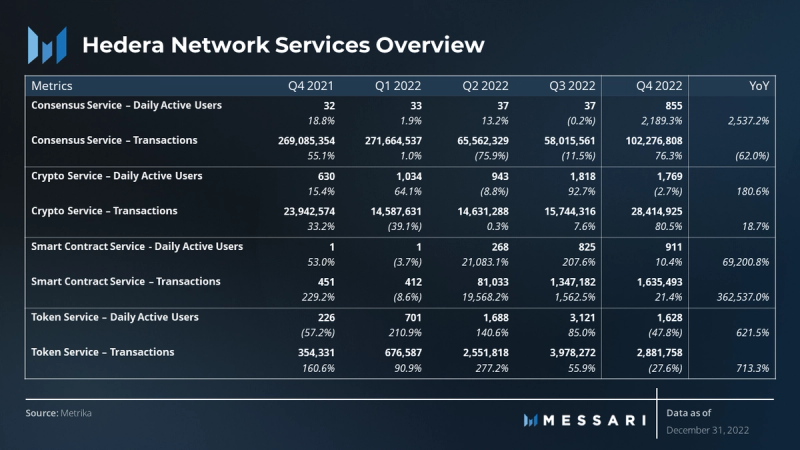
The Hedera Network Services, which include the Consensus Service, Crypto Service, Smart Contract Service, and Token Service, make up the Hedera network’s core offerings. These services are supported by the Hashgraph algorithm, with a fixed fee structure, and offer SDKs for accessing the API in popular programming languages such as JavaScript, Java, and Go. The primary users and usage frequency of the Network Services vary depending on the service and its intended use; however, each network service is used by developers, enterprises, and retail.
During Q4, the Network Services experienced a mixed performance. The Crypto Service and Smart Contract Service experienced sustained high levels of activity following the launch of SaucerSwap in Q3. However, the Consensus Service stood out with a 23-fold increase in daily active users and a doubling in transactions. On the other hand, the Token Service had a weaker quarter but remained consistent with previous quarters.
When evaluated on a YoY basis, the Network Services have demonstrated significant growth across all offerings. Despite the difficult market conditions, this growth indicates a continued development and adoption of the Hedera Network.
Hedera Consensus Service
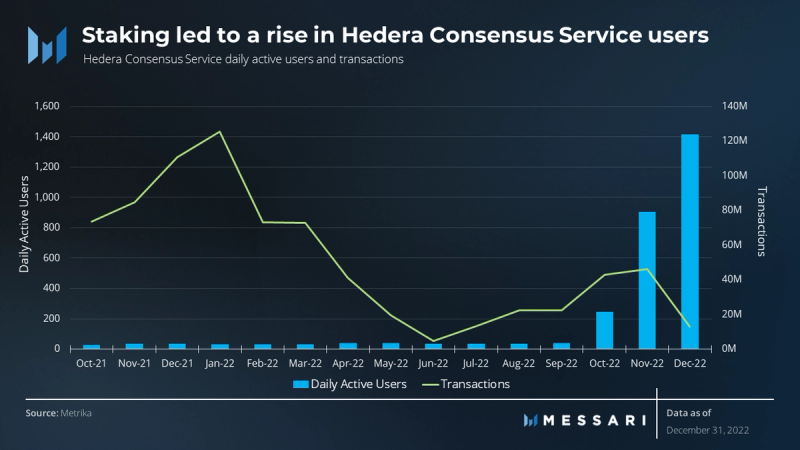
The Hedera Consensus Service enables the verifiable time-stamping and ordering of events for Web2 and Web3 applications. Users submit messages to the Hedera Network, where the messages are time-stamped and ordered by the Hashgraph algorithm. These messages are used to form an auditable history of verifiable and trustless events. The Consensus Service is utilized by various applications such as tracking of supply chain provenance, logging of asset transfers between blockchain networks, counting votes in a decentralized autonomous organization (DAO), monitoring Internet of Things (IoT) devices, and more.
In Q4, the Consensus Service experienced remarkable growth with a 23-fold increase in daily active users, from 37 to 855, reaching an all-time high, and doubling in transactions from 50 million to 100 million. This spike in activity was attributed to the launch of staking. However, it is worth noting the majority of transactions on the Consensus Service come from enterprise usage. For instance, Avery Dennison is incorporating the Consensus Service into its cloud platform to track customer carbon emissions.
Hedera Crypto Service
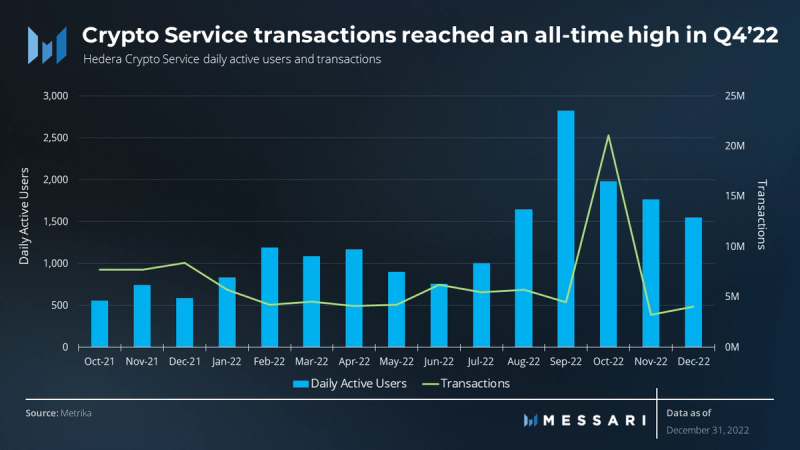
The Hedera Crypto Service enables users to perform basic operations on the Hedera Network. These operations include transferring fungible and non-fungible tokens, creating and updating accounts, clearing accounts, and approving account allowances.
In Q3, the Crypto Service recorded a significant increase in daily active users, doubling from 900-1,800, reaching a new record high. The launch of SaucerSwap primarily drove this growth. The launch of DEXs HeliSwap and Bubbleswap in Q4 sustained the momentum, resulting in Hedera setting a new all-time high of 28 million transactions, while the number of users remained relatively stable near all-time highs.
Hedera Smart Contract Service
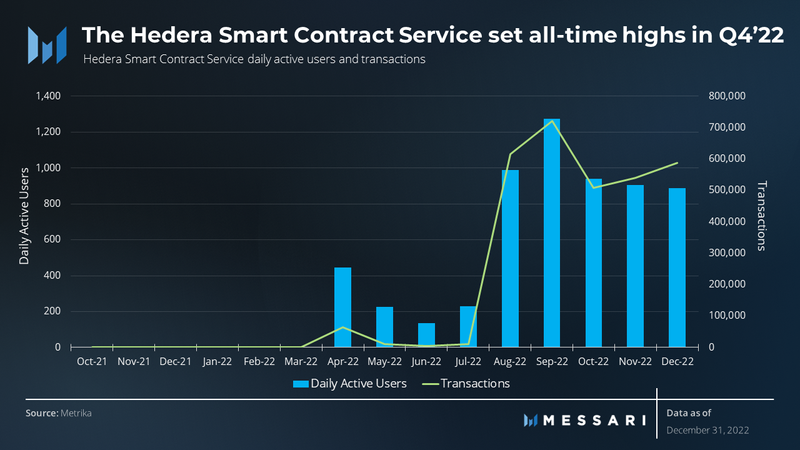
The Hedera Smart Contract Service enables developers to create and deploy smart contracts to power their applications, with benefits such as no congestion, guaranteed cost and seamless integration with the Hedera Token Service to create and deploy fungible and non-fungible tokens. In February 2022, the launch of Smart Contracts 2.0 introduced EVM compatibility, support for Solidity-based smart contracts, and core Ethereum tooling, resulting in a steady growth of the service.
During Q4, the momentum continued as the Smart Contract Service set an all-time high in both daily active users and transactions. Similar to the other services, the increases were driven by the sustained success of SaucerSwap in Q3 and the launch of new DEXs HeliSwap and Bubbleswap in Q4.
Hedera Token Service
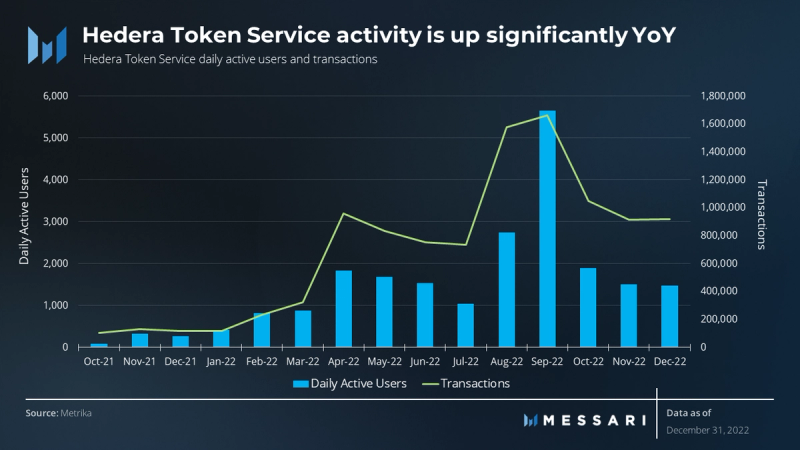
The Hedera Token Service allows users to configure, mint, and manage their own fungible and non-fungible tokens. Following all-time highs in daily active users and transactions Q3, both metrics reverted back to Q2 levels. Nonetheless, both numbers are still significantly higher on a YoY basis. This growth is due to an increase in both NFT and DeFi usage on Hedera.
Qualitative Analysis
Governance

The Hedera Governing Council is a group of organizations that support the growth and development of Hedera, including operating Hedera validator nodes. In Q4, the Council added its 27th member, abrdn, a Scottish asset management company. The Council is made up of a maximum of 39 members, each of whom has an equal vote in Hedera’s decision-making process. The Council also announced the appointment of Nilmini Rubin, a former contributor to Meta’s global policy and the National Security Council’s director for international finance, as Chief of Staff and Head of Global Policy, and Betsabe Botaitis, who has held senior positions at Uplift, Lending Club, and Citigroup, as Chief Financial Officer to the executive team.
As the network grows, Hedera expects thousands of permissionless public nodes to eventually support the network. Council members serve three-year terms (with a maximum of two consecutive terms) and have an equal vote in decisions related to the network and platform. Swirlds, the creator of Hashgraph, holds a permanent seat on the Council but does not have any additional privileges. The Council’s main focus is on the decentralized governance of the network in order to ensure stability and to manage the Hedera Treasury.
The Council holds a monthly meeting and publishes minutes from the meeting. Meeting minutes are published within 30 days of approval by the Council, typically a few weeks following each subsequent Council meeting. Meeting records are immutable and recorded on Hedera using ProvenDB.
- October meeting – The Council members directed the Technical Steering & Product Committee not to approve HIP 498 and to investigate alternative implementations of the feature. The Council members approved the Open Source Task Force’s recommendation for (i) an open source project scope focused on the Hedera Mainnet implementation and complementary projects and (ii) an open source governance structure based on a Linux Foundation / Cloud Native Computing Foundation model.
- November meeting – No meeting, as the council had an extended, in-person meeting in Dubai the previous month.
- December meeting – Minutes will be approved and published after the subsequent council meeting.
Community members can participate in governance through Hedera Improvement Proposals (HIPs). These proposals can cover a range of topics, including changes to the core protocol as well as changes to applications, frameworks, and protocols built atop the Hedera public network and used by the community. The author of a HIP is responsible for building consensus within the community, documenting any dissenting opinions, and following the proposal through the process.
During Q4, several important Hedera Improvement Proposals (HIPs) were passed including:
- HIP-542: Payer-sponsored auto-account creation with HTS assets – Enables the ability to send fungible and non-fungible tokens to aliases that do not exist on the network. This allows creators, developers, etc., to more easily onboard users.
- HIP-564: Zero unit token operations in smart contracts – Enables smart contract developers to specify a zero value for contract function, removing the need to implement if statement or logic. This eases the migration of existing applications to Hedera as the behavior when passing zero tokens to contract functions mirrors other chains.
- HIP-573: Blanket exemptions for custom fee collectors – Enables developers whose tokenomics require custom fees and different collection accounts to exempt collectors from paying custom fees when exchanging token units.
Treasury
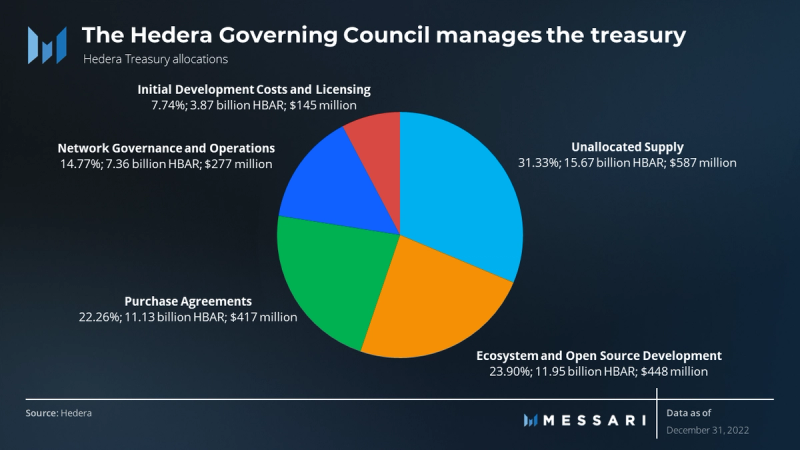
Hedera was created with a total supply of 50 billion HBAR. The total supply can only be changed with the unanimous approval of the Hedera Governing Council. The unallocated HBAR in the Hedera Treasury are controlled by the Hedera Governing Council. Any transfer of coins out of the Treasury must receive a majority vote from the Council.
The latest Hedera Treasury Fund Management report, published in late December, stated 25.3 billion HBAR (50.61%) are in circulation. Hedera also mentioned that it has no exposure to Genesis or FTX.
Staking
The Hedera Network leaderless utilizes a Proof-of-Stake consensus mechanism where each node’s influence is determined by the amount of HBAR it has staked. To reach agreement on a transaction, approval from two-thirds of the total HBAR staked is required. Currently, the Hedera Governing Council oversees the validator nodes as the network moves towards permissionless node hosting. Nodes have a minimum and maximum stake limit, with the maximum being 1.85 billion HBAR per node, calculated as the total number of HBAR divided by the number of nodes on the network. The minimum stake is one-fourth of the maximum stake, 460 million HBAR, and is required to receive rewards.
In June, the Hedera Network made significant progress towards decentralization with the implementation of HIP-406: Staking. This proposal outlined a four-stage plan for decentralization. The first two phases were launched in June and July, enabling users to stake HBAR and influence the consensus weight of nodes, but no rewards were distributed yet.
In October, Phase 3 of staking was launched, allowing for staking rewards. Accounts need to stake for a minimum of 24 hours to qualify for rewards. The Hedera Governing Council established a maximum annual reward rate of 6.5%; however, the actual reward rate will fluctuate depending on the amount of HBAR staked for rewards. By the end of Q4, approximately 32 billion HBAR were staked by 21,000 stakers. This includes the Hedera Treasury, Swirlds, and Swirlds labs which are staking a percentage of the Treasury to help validators meet the minimum staking amount. The final phase of staking, Phase 4, is expected to go live in the near future and complete the rollout of staking functionality.
Closing Summary
The crypto industry experienced a tumultuous year, and the collapse of FTX in Q4 added to the challenges. Despite the difficulties, Hedera Hashgraph was able to sustain its growth and continue to gain adoption.
During Q4, Hedera Hashgraph’s network fundamentals continued to show growth, with transfer volume and transactions increasing by 123% and 70%, respectively QoQ. At the same time, the number of daily active users and new accounts saw a slight decrease after reaching all-time highs in Q3; however, it still remained well above previous quarters. The uptick in network activity was driven by both the DeFi and NFT ecosystems.
In Q4, the DeFi ecosystem on Hedera saw the launch of two new DEXs, HeliSwap and Bubbleswap, which together attracted $10 million in TVL. SaucerSwap, which launched in Q3, remained the dominant DEX with $13 million TVL at the end of Q4, bringing the total TVL for the DEXs on Hedera to $23 million. Additionally, Hedera’s network is the leading platform for the liquid staking protocol Stader, which had $49 million in TVL.
In the NFT ecosystem, Hedera continued to see strong activity following a record-breaking Q3. Several exciting new projects were launched or announced for launch, and the HBAR foundation announced funding for multiple games.
During Q4, the Hedera Network Services set new all-time highs, with the Consensus Service, Crypto Service, and Smart Contract Service experiencing significant growth. The Token Service, however, showed less progress. A YoY analysis shows that all of the Network Services have demonstrated substantial growth, indicating continued development and adoption of the Hedera Network despite the challenging market conditions.
Despite the bear market, Hedera’s core developers persisted in building and expanding the network, resulting in increased adoption. In 2023, many new projects are expected to launch on the network as funding rounds bring in new resources.


